Abstract
Plant leaf diseases have always been a matter of concern for farmers. With the increasing population, the demand for crops has increased which makes it very necessary and more important to not let the crops get damaged by viruses and bacteria. With the development of computer vision technologies and machine learning algorithms, it is easier now, than ever to use computers for the help of farmers in the early diagnosis of plant diseases and locating the infected portions of a plant. The existing computer vision models have seen considerable advancements in deep learning, the proposed approach is to integrate a few of them together to come up with an advanced model for classifying and localising the diagnosis of leaf diseases through coloured images. This paper proposes an algorithm ensembling a few state-of-the-art models in classification and object detection to build a model for Cassava leaf disease detection. The proposed ensemble model is found to achieve the categorization accuracy value of 90.75% on the Cassava leaf disease dataset by Makerere University.
Access this chapter
Tax calculation will be finalised at checkout
Purchases are for personal use only
Similar content being viewed by others
References
Albawi S, Mohammed TA, Al-Zawi S (2017) Understanding of a convolutional neural network. In Proceedings of the international conference on engineering and technology, pp 1–6
Chan TH, Jia K, Gao S, Lu J, Zeng Z, Ma Y (2015) PCANet: a simple deep learning baseline for image classification? IEEE Trans Image Process 24(12):5017–5032
Dosovitskiy A, Beyer L, Kolesnikov A, Weissenborn D, Zhai X, Unterthiner T, Dehghani M, Minderer M, Heigold G, Gelly S, et al (2020) An image is worth 16x16 words: transformers for image recognition at scale. arXiv preprint arXiv:2010.11929
Ganaie M, Hu M, et al (2021) Ensemble deep learning: a review. arXiv preprint arXiv:2104.02395
Ghorpade J, Parande J, Kulkarni M, Bawaskar A (2012) GPGPU processing in CUDA architecture. arXiv preprint arXiv:1202.4347
Google: TensorFlow CropNet Cassava disease classification model. https://tfhub.dev/google/cropnet/classifier/cassava_disease_V1/2. [Online; accessed 20-July-2022]
He K, Zhang X, Ren S, Sun J (2016) Deep residual learning for image recognition. In Proceedings of the IEEE conference on computer vision and pattern recognition (CVPR), pp 770–778
Howard A, Sandler M, Chen B, Wang W, Chen LC, Tan M, Chu G, Vasudevan V, Zhu Y, Pang R, Adam H, Le Q (2019) Searching for MobileNetV3. In Proceedings of the IEEE/CVF international conference on computer vision, pp 1314–1324
Howard AG, Zhu M, Chen B, Kalenichenko D, Wang W, Weyand T, Andreetto M, Adam H (2017) Mobilenets: efficient convolutional neural networks for mobile vision applications. arXiv preprint arXiv:1704.04861
Hu J, Shen L, Sun G (2018) Squeeze-and-excitation networks. In Proceedings of the IEEE/CVF conference on computer vision and pattern recognition, pp 7132–7141
Janiesch C, Zschech P, Heinrich K (2021) Machine learning and deep learning. Electron Mark 31(3):685–695
Kumar H (2022) Kaggle Cassava leaf disease detection. https://www.kaggle.com/code/hrishikesh1kumar/cassava-leaf-disease-detection. Accessed on 20 Jul 2022
Liu Z, Mao H, Wu CY, Feichtenhofer C, Darrell T, Xie S (2022) A ConvNet for the 2020s. arXiv preprint arXiv:2201.03545
Mohanty SP, Hughes DP, Salathé M (2016) Using deep learning for image-based plant disease detection. Front Plant Sci 7:1419
Mwebaze E, Gebru T, Frome A, Nsumba S, Tusubira J (2019) Cassava 2019 fine-grained visual categorization challenge. arXiv preprint arXiv:1908.02900
Ramcharan A, Baranowski K, McCloskey P, Ahmed B, Legg J, Hughes DP (2017) Deep learning for image-based cassava disease detection. Front Plant Sci 8:1852
Raschka S (2018) Model evaluation, model selection, and algorithm selection in machine learning. arXiv preprint arXiv:1811.12808
Refaeilzadeh P, Tang L, Liu H (2009) Cross-validation. Encycl Database Syst 532–538
Schapire RE (2003) The boosting approach to machine learning: an overview. In Nonlinear estimation and classification, pp 149–171
Shanmugam D, Blalock D, Balakrishnan G, Guttag J (2021) Better aggregation in test-time augmentation. In Proceedings of the IEEE/CVF international conference on computer vision, pp 1214–1223
Shkliarevskyi M (2022) Kaggle Cassava leaf disease: Keras CNN prediction. https://www.kaggle.com/code/maksymshkliarevskyi/cassava-leaf-disease-keras-cnn-prediction. Accessed on 20 Jul 2022
Solovyev R, Wang W, Gabruseva T (2021) Weighted boxes fusion: ensembling boxes from different object detection models. Image Vis Comput 107:104–117
Sutskever I, Vinyals O, Le QV (2014) Sequence to sequence learning with neural networks. Adv Neur Inform Process Syst 27
Szegedy C, Vanhoucke V, Ioffe S, Shlens J, Wojna Z (2016) Rethinking the inception architecture for computer vision. In Proceedings of the IEEE conference on computer vision and pattern recognition, pp 2818–2826
Tan M, Le Q (2019) Efficientnet: rethinking model scaling for convolutional neural networks. In Proceedings of the international conference on machine learning, pp 6105–6114
Touvron H, Cord M, Douze M, Massa F, Sablayrolles A, Jégou H (2021) Training data-efficient image transformers and distillation through attention. In Proceedings of the international conference on machine learning, pp 10347–10357
Vaswani A, Shazeer N, Parmar N, Uszkoreit J, Jones L, Gomez AN, Kaiser LU, Polosukhin I (2017) Attention is all you need. In Advances in neural information processing systems, Vol 30. Curran Associates, Inc.
Wolpert DH (1992) Stacked generalization. Neur Netw 5(2):241–259
Xie S, Girshick R, Dollár P, Tu Z, He K (2017) Aggregated residual transformations for deep neural networks. In Proceedings of the IEEE conference on computer vision and pattern recognition, pp 5987–5995
Author information
Authors and Affiliations
Corresponding author
Editor information
Editors and Affiliations
Rights and permissions
Copyright information
© 2023 The Author(s), under exclusive license to Springer Nature Singapore Pte Ltd.
About this paper
Cite this paper
Kumar, H., Velu, S., Lokesh, A., Suman, K., Chebrolu, S. (2023). Cassava Leaf Disease Detection Using Ensembling of EfficientNet, SEResNeXt, ViT, DeIT and MobileNetV3 Models. In: Yadav, R.P., Nanda, S.J., Rana, P.S., Lim, MH. (eds) Proceedings of the International Conference on Paradigms of Computing, Communication and Data Sciences. Algorithms for Intelligent Systems. Springer, Singapore. https://doi.org/10.1007/978-981-19-8742-7_15
Download citation
DOI: https://doi.org/10.1007/978-981-19-8742-7_15
Published:
Publisher Name: Springer, Singapore
Print ISBN: 978-981-19-8741-0
Online ISBN: 978-981-19-8742-7
eBook Packages: Intelligent Technologies and RoboticsIntelligent Technologies and Robotics (R0)




